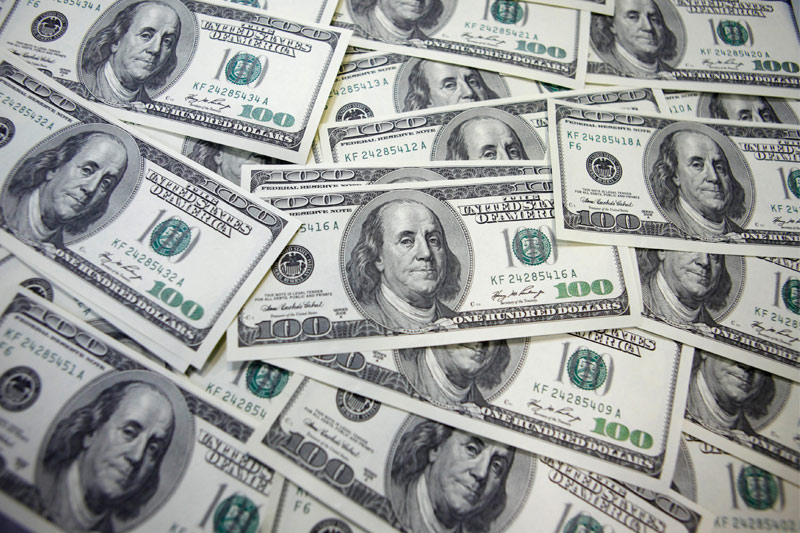Scotiabank lifts gold price forecast and upgrades Newmont, Barrick
Investing.com - The U.S. dollar drifted higher Thursday as traders weighed up fresh trade threats between Washington and Beijing, ahead of the release of key inflation data.
At 03:50 ET (07:50 GMT), the Dollar Index, which tracks the greenback against a basket of six other currencies, traded 0.1% higher to 98.805, bouncing after recording hefty losses last week.
Safe-haven dollar edges higher
The safe-haven dollar has edged slightly higher as traders have worried about the fragile state of U.S.-China relations, amid fears of a potentially damaging trade war between the world’s two largest economies.
Trump’s administration is considering a plan to restrict a broad array of software-powered exports to China, including laptops, jet engines, and other high-tech products, in response to Beijing’s latest rare earth export restrictions, Reuters reported.
The U.S. president and Chinese President Xi Jinping are expected to meet in South Korea next week, and while Trump has expressed optimism about the talks, he also acknowledged that a meeting may not take place.
Additionally, Trump has announced sanctions on Russia’s largest oil companies, Lukoil and Rosneft, with his administration citing Moscow’s “lack of serious commitment to a peace process to end the war in Ukraine.”
This has resulted in strong gains for crude oil, which are denominated in dollars.
However, “the move has merely unwound October’s losses so far, and we’d likely need to see Brent heading to $70 [from the current $64 a barrel] to result in tangible support for USD,” said ING analyst Francesco Pesole, in a note.
The U.S. government shutdown continues, but the September consumer price index is set to be released on Friday, more than a week late, and may be the next catalyst for a major dollar move.
“We reiterate our view that the dollar’s rebound is getting tired and probably requires some hawkish repricing to keep going,” said Pesole. “We don’t think tomorrow’s U.S. CPI will offer that opportunity as we expect a consensus 0.3% MoM core print. But surely with 50bp of easing fully priced in by year-end, any hot print could offer good support to the dollar.”
Euro slips slightly
In Europe, EUR/USD traded 0.2% lower to 1.1592, with the single currency slipping slightly after the White House announced sanctions on Russia’s largest oil companies, Lukoil and Rosneft, citing Moscow’s “lack of serious commitment to a peace process to end the war in Ukraine.”
“EUR/USD is hovering around 1.160, a level that, in our view, can work as an anchor again today and possibly for a few more days should U.S. CPI fail to add much to the dollar narrative,” said ING’s Pesole.
The European Central Bank is set to meet next week, but very little is expected given inflation is holding around its 2% target and the growth outlook for the wider eurozone economy looks stable.
GBP/USD slipped slightly lower to 1.3351, with sterling under a little pressure after data on Wednesday showed consumer inflation held steady at 3.8% last month, defying expectations for an acceleration to 4.0%.
Yen remains weak
Elsewhere, USD/JPY traded 0.4% higher to 152.58, climbing to its highest level in nine days, with the Japanese currency remaining weak after Liberal Democratic Party leader Sanae Takaichi became the country’s prime minister earlier in the week.
Takaichi is widely viewed as a fiscal dove, and is expected to loosen fiscal and monetary conditions in the country, which heralds pressure on the yen.
That said, the Bank of Japan has signaled that it will keep raising interest rates if growth and inflation improve in line with its forecasts, and consumer inflation data for September is due on Friday, just days before the BOJ’s late-October meeting.
USD/CNY slipped marginally lower to 7.1229, following a series of strong midpoint fixes by the People’s Bank.
Concerns over U.S.-China trade ructions resurfaced this week after reports on Wednesday showed Washington considering curbs on a slew of software-powered exports to China, in retaliation for the country’s recent rare earth export restrictions.
AUD/USD rose 0.3% to 0.6506, and NZD/USD gained 0.1% to 0.5746.
